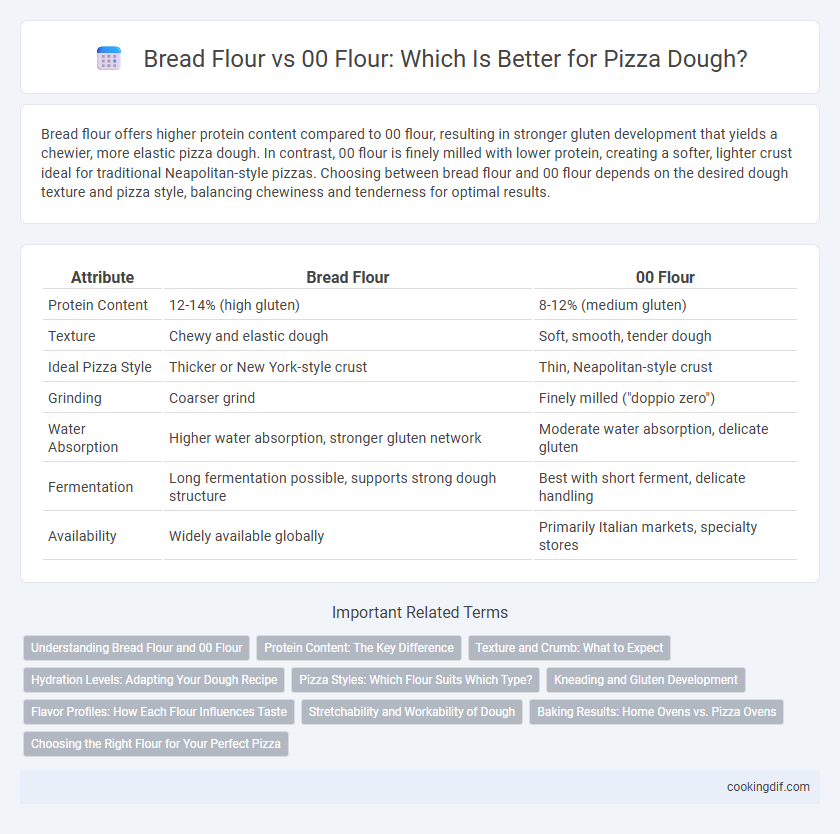Bread flour offers higher protein content compared to 00 flour, resulting in stronger gluten development that yields a chewier, more elastic pizza dough. In contrast, 00 flour is finely milled with lower protein, creating a softer, lighter crust ideal for traditional Neapolitan-style pizzas. Choosing between bread flour and 00 flour depends on the desired dough texture and pizza style, balancing chewiness and tenderness for optimal results.
Table of Comparison
| Attribute | Bread Flour | 00 Flour |
|---|---|---|
| Protein Content | 12-14% (high gluten) | 8-12% (medium gluten) |
| Texture | Chewy and elastic dough | Soft, smooth, tender dough |
| Ideal Pizza Style | Thicker or New York-style crust | Thin, Neapolitan-style crust |
| Grinding | Coarser grind | Finely milled ("doppio zero") |
| Water Absorption | Higher water absorption, stronger gluten network | Moderate water absorption, delicate gluten |
| Fermentation | Long fermentation possible, supports strong dough structure | Best with short ferment, delicate handling |
| Availability | Widely available globally | Primarily Italian markets, specialty stores |
Understanding Bread Flour and 00 Flour
Bread flour contains higher protein content, typically around 12-14%, which creates more gluten for a chewier and more elastic pizza dough. 00 flour is finely milled with lower protein levels, usually 8-10%, producing a softer, tender crust with a delicate texture ideal for Neapolitan-style pizzas. Understanding the protein differences and milling processes helps bakers choose the right flour based on desired dough elasticity and crust characteristics.
Protein Content: The Key Difference
Protein content is the key difference between bread flour and 00 flour in pizza dough making, with bread flour typically containing 12-14% protein compared to 00 flour's 8-11%. Higher protein levels in bread flour contribute to stronger gluten formation, resulting in a chewier, more elastic crust. In contrast, 00 flour's lower protein content yields a softer, more tender dough ideal for thin-crust pizzas.
Texture and Crumb: What to Expect
Bread flour yields a chewier texture and a more open crumb due to its higher protein content, which develops stronger gluten networks. In contrast, 00 flour produces a finer, softer crumb with a tender bite, ideal for traditional Neapolitan-style pizza crusts. Choosing between bread flour and 00 flour ultimately affects dough elasticity, oven spring, and the overall mouthfeel of the pizza crust.
Hydration Levels: Adapting Your Dough Recipe
Bread flour typically absorbs more water than 00 flour due to its higher protein content, resulting in doughs with higher hydration levels that offer increased elasticity and chewiness. Pizza dough made with 00 flour usually requires slightly less water to maintain a soft, tender texture, ideal for thin-crust Neapolitan-style pizzas. Adjusting hydration according to flour type enhances gluten development and dough handling, directly impacting crust texture and overall pizza quality.
Pizza Styles: Which Flour Suits Which Type?
Bread flour, known for its high protein content of around 12-14%, creates a chewier texture ideal for New York-style and thicker crust pizzas. 00 flour, finely milled with moderate protein (8-12%), produces a tender, elastic dough perfect for Neapolitan pizza, allowing for that characteristic thin, soft, and slightly crispy crust. Choosing flour depends on the desired pizza style: bread flour supports a sturdy, chewy base, while 00 flour enhances stretchability and crispness for traditional Italian pies.
Kneading and Gluten Development
Bread flour contains a higher protein content (12-14%) than 00 flour (8-11%), which significantly enhances gluten development during kneading, resulting in a chewier and more elastic pizza dough. Kneading bread flour dough requires a longer and more intense process to fully activate the gluten network, providing better dough strength and gas retention for a thicker crust. Conversely, 00 flour produces a softer dough with less gluten, requiring gentler kneading to maintain the dough's delicate structure and achieve a tender, thin crust typical of Neapolitan-style pizzas.
Flavor Profiles: How Each Flour Influences Taste
Bread flour, with its higher protein content, creates a chewier crust and enhances the dough's ability to develop complex flavors during fermentation, resulting in a robust, slightly nutty taste. 00 flour, finely milled and lower in protein, produces a softer, more delicate crust with a subtle sweetness and a light, airy texture that highlights the freshness of toppings. The choice between bread flour and 00 flour significantly impacts the pizza's overall flavor profile, balancing texture with the depth of taste.
Stretchability and Workability of Dough
00 flour offers superior stretchability and workability for pizza dough due to its finely milled texture and lower protein content, resulting in a smooth, elastic dough that is easy to shape. Bread flour, with a higher protein level, creates a stronger gluten network, yielding a chewier and firmer dough but requiring more effort to stretch and shape evenly. Selecting 00 flour is ideal for achieving thin, flexible pizza crusts, while bread flour suits thicker, more robust crusts that hold their shape under toppings.
Baking Results: Home Ovens vs. Pizza Ovens
Bread flour yields a chewier crust with a higher gluten content, ideal for home ovens that typically bake at lower temperatures around 450degF (230degC). In contrast, 00 flour produces a softer, more elastic dough with a delicate texture suited for pizza ovens reaching temperatures above 800degF (427degC), creating the signature Neapolitan-style crust. Using 00 flour in home ovens may result in underdeveloped texture, while bread flour may not achieve the lightness and char of a high-temperature pizza oven bake.
Choosing the Right Flour for Your Perfect Pizza
Choosing the right flour is crucial for achieving the perfect pizza dough texture and flavor. Bread flour, with its higher protein content (around 12-14%), develops more gluten, resulting in a chewier, more elastic crust ideal for New York-style pizzas. In contrast, 00 flour, finely milled with lower protein (approximately 11-12%), produces a tender, airy crust favored in traditional Neapolitan pizzas due to its smooth, silky dough consistency and optimal stretch.
Bread flour vs 00 flour for dough making Infographic

 cookingdif.com
cookingdif.com